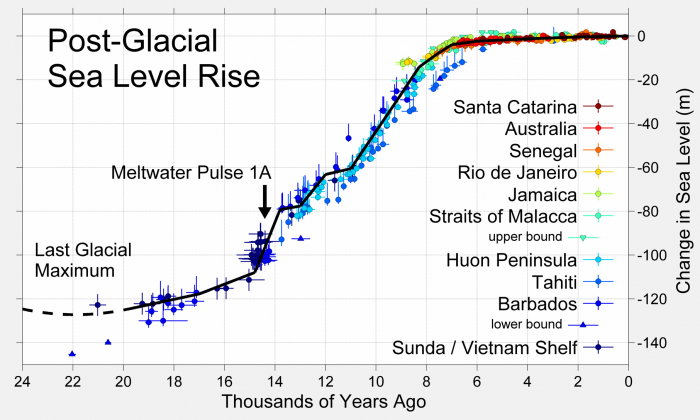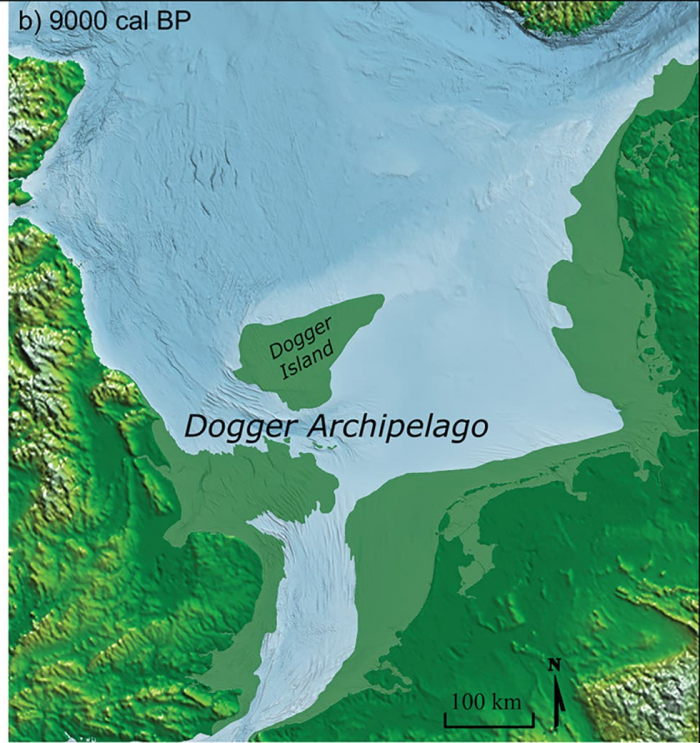Doggerland - the last European land of the Neanderthals, lies under the North Sea today
(Article based on Esther Widmann's article "Doggerland, Atlantis of the hunter-gatherers, lies under the North Sea", published in NZZ 24.07.2018).
Just over 8,000 years ago, a tsunami1 finally washed away the land bridge between Scandinavia and Britain. Archaeologists travel2 in a special ship to find traces of an ancient settlement.
A suggestion for the plot of a disaster film: people see that the sea is getting closer and closer, engulfing more and more of their surroundings. Some move further away from the water and try their best to come to terms with those who already live there. Others endure, hoping that the worst will not happen. Perhaps there is also a cute little girl who always wears a little hat. And then the wave comes. Ten metres high and faster than a man can run. The final image of the film is a ghostly smooth sheet of water on which the little hat floats....
Not interested in films about climate change? You don't think the plot is original, it's all been done before? You're right: everything has already been there, around 6100 BC. The sea level had previously been rising by one to two metres per century for 11,000 years after the end of the Ice Age, and then quite suddenly by about 60 centimetres, and finally a huge tsunami washed out the land bridge between Britain and what the Brits like to call 'the continent', all the way to Scandinavia.

Beneath the North Sea is an area of some 30,000 square kilometres where humans have lived for thousands of years3: Doggerland.
1 further in the article we read: " About 8200 years ago, a huge landslide, known as Storegga, occurred 800 kilometres off the coast of Norway. It triggered a tsunami", we speak here about.
2 in year 2018.
3 these people are representatives of the last Species of Neanderthals (Homo sapiens Neanderthalensis), whom our Unified Science calls "Evolutionary Atlantes" because it is their descendants (children, grandchildren and great-grandchildren) that enabled the further evolution of our Family Homo sapiens, giving rise to our Genus and Species Homo sapiens Sapiens (compare the diagram below).


Scientists from England and Belgium have just started exploring the seabed for traces of former human inhabitants using a specialised vessel. This year and next year1 they will be collecting geophysical data and extracting drill cores from the seabed. Vince Gaffney, an archaeologist at the University of Bradford in England, is pinning his hopes on Brown Bank, a 30-kilometre shoal between England and the Netherlands. The water depth here ranges from 18 to 20 metres. This is where the archaeological finds to date are concentrated. "Until now, most of Doggerland has been terra incognita from an archaeological point of view," - Gaffney says. "If we found a settlement, it would be a big deal."
1 we remember, the article has been written in year 2018.
Back in the 19th century, the bones of extinct land animals such as aurochs and mammoths that landed in fishing nets provided concrete evidence of an underwater landmass beneath the North Sea. In 1931, fishermen 40 kilometres off the coast brought to the surface a lump of peat containing an ornamental bone harpoon from the Middle Stone Age (Mesolithic, c. 9000-4000 BC) - the first clear evidence of prehistoric human presence on the seabed. But then Doggerland was largely forgotten for decades. It is only in the last 15 years that scientists have increasingly focused on the cultural heritage beneath the North Sea.
Even human remains, such as a Neanderthal bone, have been found on the seabed. In 2013, a fishing boat brought a human skull bone to the surface near Rotterdam. Recently published C14 dating revealed an age of around 11,050 years1. Analysis of some of the isotopes in the bone, which can be used to reconstruct the diet during a person's lifetime, shows that this individual's protein sources were mainly on land rather than in the sea. This is because the sea was still far away at the time.
Gaffney and his colleagues mapped the area using reflection seismic: The geological composition of the seabed is studied using artificially generated seismic waves; a technique typically used in the service of oil extraction companies. Scientists have discovered a network of rivers - the Rhine and Thames were then much longer than they are today - and freshwater lakes.
1 it was therefore a representative of the penultimate Species of the Neanderthal Genus, which our Unified Time Scale clearly assigns to the Regular Atlantean Species (compare the diagram above).

Where the North Sea is today, there was once Doggerland. Gaffney says that this landscape was very attractive to the population groups of the time. Myself, I even think that the Neanderthals of the time lived like in paradise. Herds of mammals grazed on the plain, and fish and birds were abundant. Stone tools from the seabed show that animals were hunted and cut.

"For thousands of years, people in the south did not realise that their northern coast was getting closer," - Gaffney explains. "Then all of a sudden it happened quite quickly and they probably saw that the land they knew as children had suddenly disappeared." Doggerland was probably only an island 9000 years ago.

About 8200 years ago, a huge landslide, known as Storegga, occurred 800 kilometres off the coast of Norway. It triggered a tsunami that engulfed all other land and islands. In England, this wave can still be traced 40 kilometres from today's coast. In addition, 3,000 cubic kilometres of sediment several metres thick was washed away by the former land bridge. "It cannot be ruled out that people could have returned after the tsunami, but the rising sea level eventually engulfed the island." Doggerland's history has come to an end.
Millennia separate this story from the archaeologists who now want to study it. And above it lies the sea.
Our Unified Time Scale fixes all dates with tremendous precision (as in the diagram above). Therefore, we can say exactly that the Storegga-landslide of the Norwegian coast occurred as a result of crustal upheaval in the course of the cosmic leap of Stage 4 of the Cosmic Hierarchy of the Solar System, the peak of which was reached 6658 years BC. (i.e. 8682 years ago). One must bow to the achievements of traditional science, which have made it possible to date the various stages of the end of the last ice age and the sinking of Doggerland so relatively correctly. What traditional science, however, has not even suspected until now is the linking of this geological event with the evolutionary quantum leap from the Neanderthal Genus to our Sapiens Genus of modern humans.

Source of the maps: Antiquity 2020 Vol. 94 (378): 1409–1425
https://doi.org/10.15184/aqy.2020.49
Research Article: "A great wave: the Storegga tsunami and the end of Doggerland?"
James Walker1 , Vincent Gaffney1,* , Simon Fitch1 , Merle Muru1,2, Andrew Fraser1 , Martin Bates3 & Richard Bates4